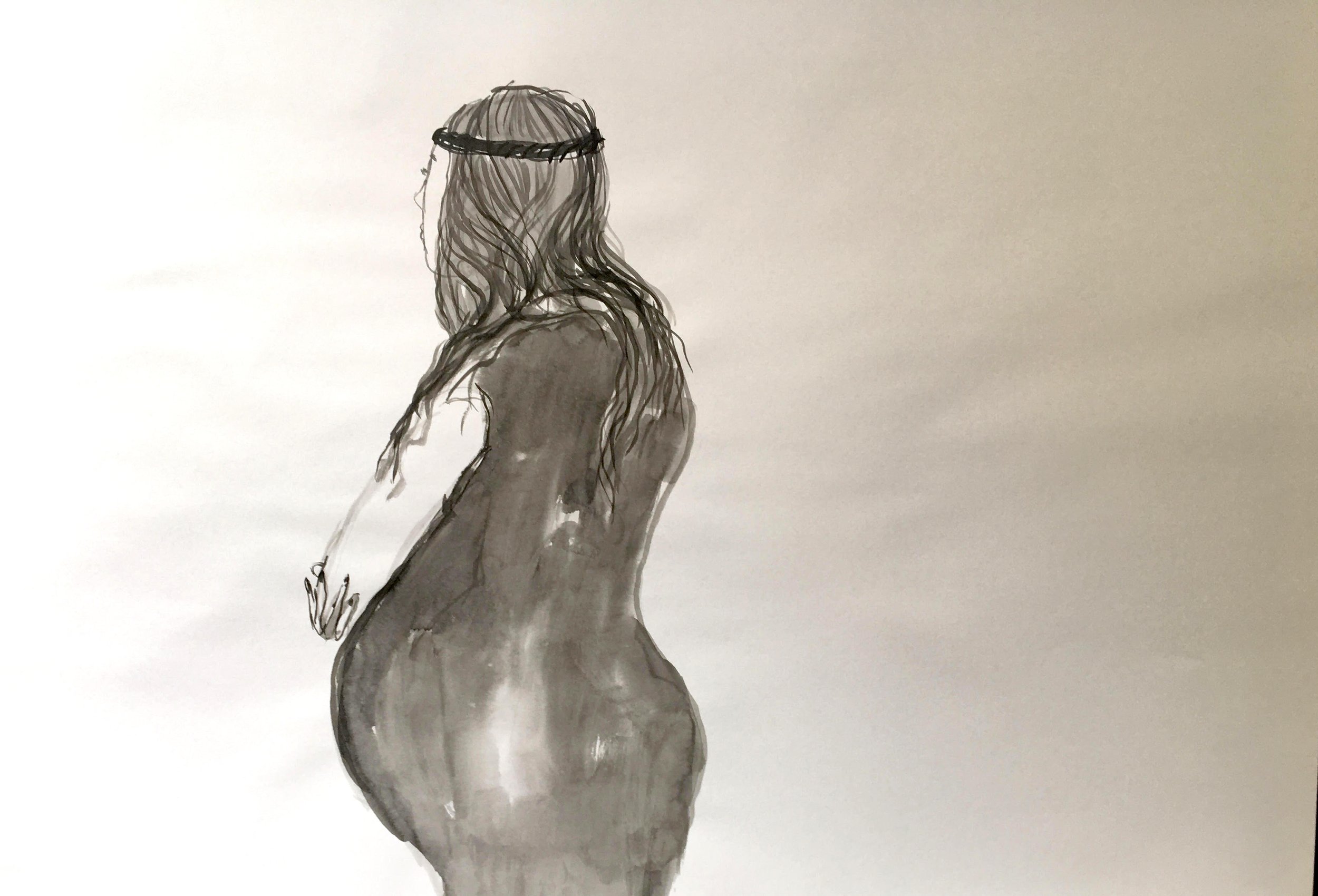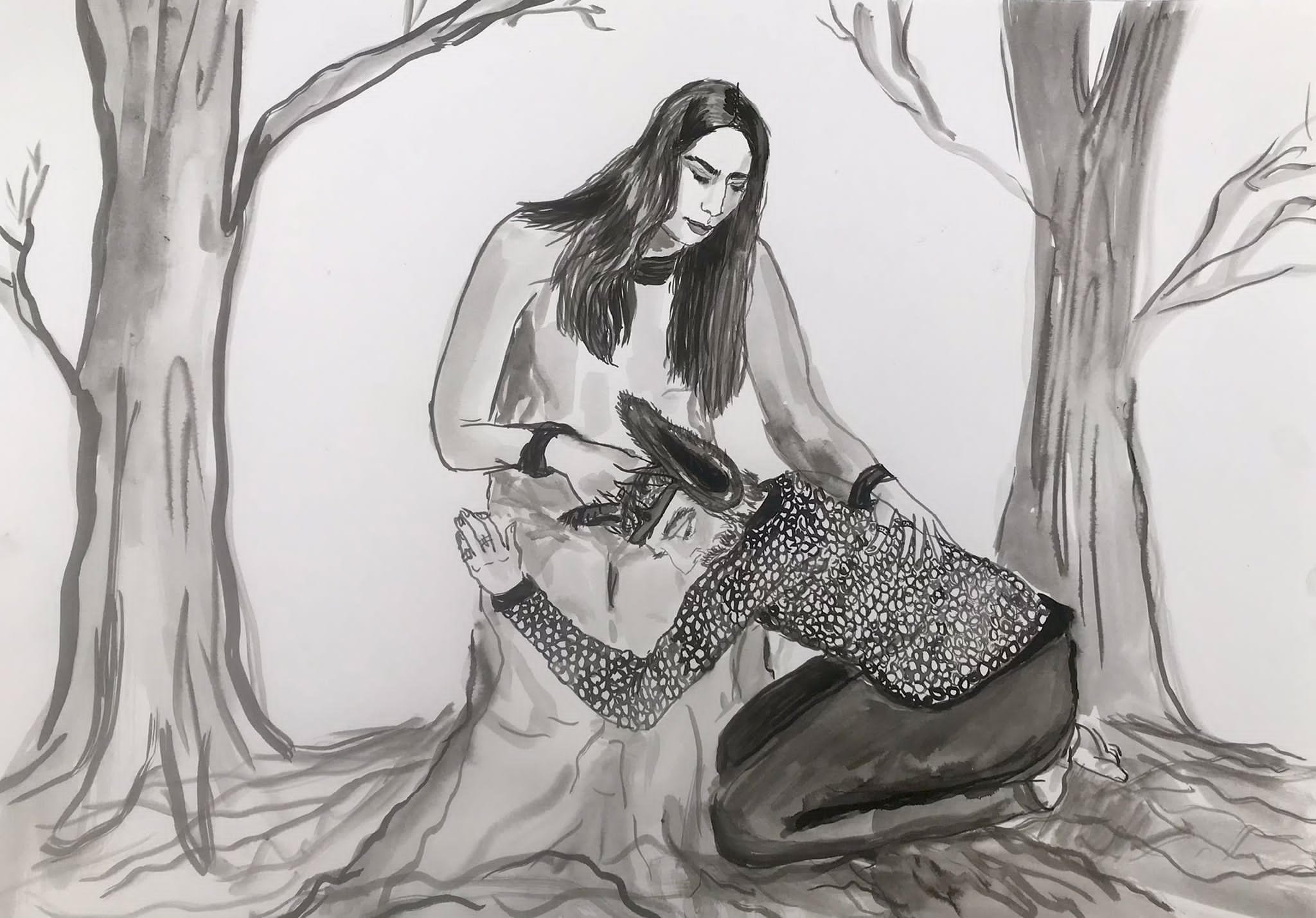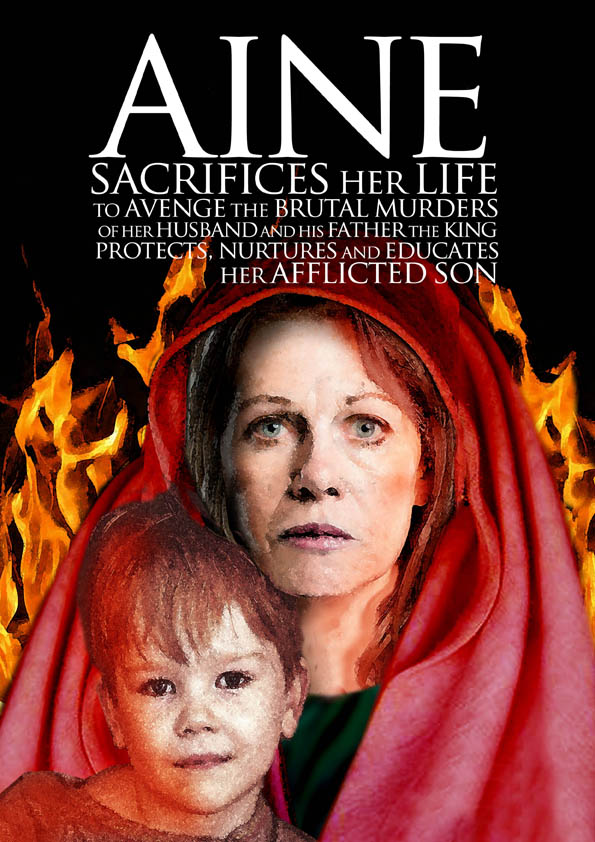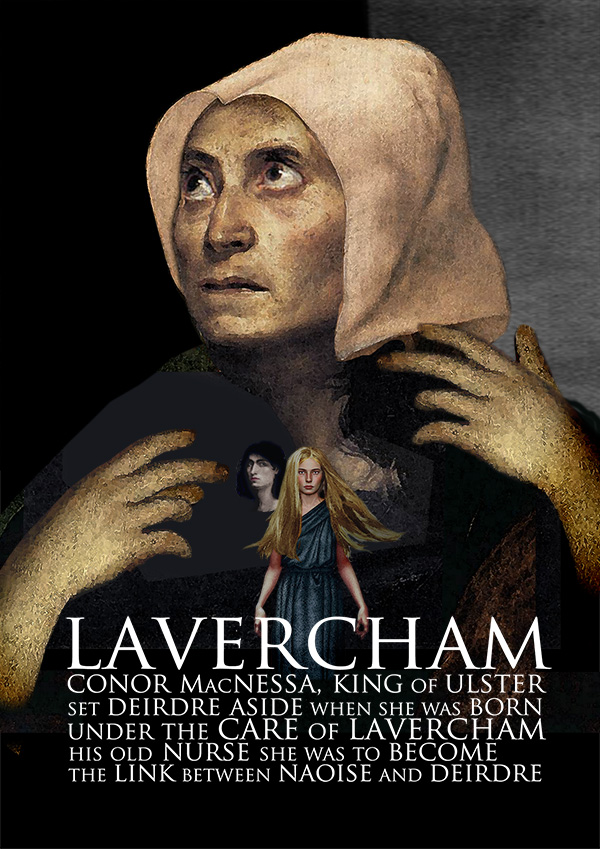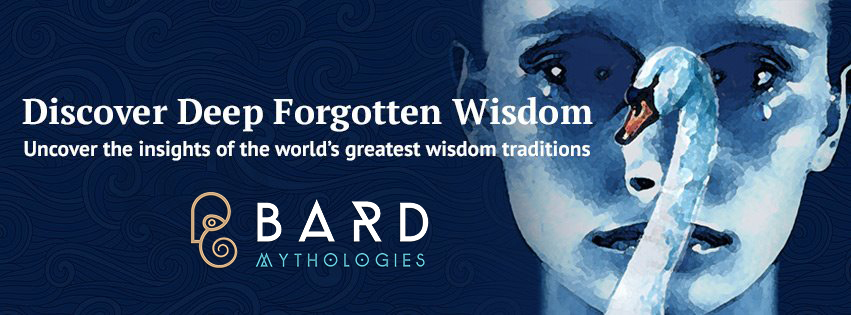Stories of Brigid, Goddess and Saint.
A Retelling by Karina Tynan
Dedicated to Melanie Lynch
Introduction
She is Brigid of the Tuatha Dé Danann, poetess and daughter of a slave woman called Broicseach and the Daghda. She is goddess and protector of domestic animals whose feast day is Imbolg, the first day of spring.
She is Saint Brigid of Kildare, founder of the church of the oak tree whose feast day is the first day of spring know as Lá Féile Bríde.
Useful notes :
Tuatha Dé Danann : People of the Goddess Danú.
Daghda : A principal deity of the The Tuatha Dé Danann
Lá Féile Bríde : St Brigid’s Day
Plámás : Empty flattery
King Labhraidh Loingseach : Mythical King of Leinster who was said to have horses ears
Leinster : A province of Ireland in the south east.
Triple Goddess Cross by Kathy Tynan
In the country in the dead of night, islanded amid a sea of sleep two hearts beat. While animals twitched and men dreamed, night hosted the unknown. Country roads away a midwife walked bringing herbs and prayers under a sea of stars.
They knew I was coming. There were signs, portents, shapes in the clouds. The moon shone bright as my mother inched me in like the tide. Then I came to her shore, wafted my way to her breast for the milk that was mine.
Her name was Broicseach; slave to a druid called Dubhthach who was known to be half way in and half way out of this world. He needed a slave he said,
“So, then I can be away from domestic underling tasks; be free to go to my wattles, my chants, portents, the magic I call for the healing of strife. That’s my task in life.”
He was a man of great things, speaking to kings who would hang on his every word so their worlds wouldn’t end. He chanted all day while she cooked and cleaned, swept and shone and when he was gone she’d scatter fresh straw on his floor with a song.
As a child I thought about fire. I saw men melting metal, shaping wheels and swords. I saw women rub stones together. At night I dreamed a fire was burning in my heart so fierce that my screams would reach into the quiet and turn to fire. Dubhthach would go wild thinking his house was burning down, calling us to fetch water. He had no idea where the buckets were kept but there was no fire.
“I was only dreaming,” I said.
I had no idea the light in me was as strong as it was. I was too young to know what was normal for a child to feel in the middle of the night. But over time he saw that I was kind. He saw me pray to everything, to every task, in the milk I poured, in the beer I brewed, in the bread I made. And he took to my ways and kindled a fire, washed his own hair, and tidied his bed along with a prayer and was able to see his way to set my mother free.
It was thought I’d be married. They found me a man but I took the eye out of his head for not looking at me right. If he had looked he would have seen the way the road rose with me when I walked but all he saw was a strangeness in me that frightened him. I could feel his relief as he went away. No, I didn’t marry and there’s nothing wrong with it. I wanted to be with the dawn, have time for the seasons, for Spring making a pain in my heart; the fledgling states of all things in their naked broken-heartedness. I shuddered for Spring, for birds with their high filled out chests made for singing, their self-importance; how the smallest bird can show the purity of one single life.
I sat under the rain and fasted.
I was slashed by the cold in the mountains.
I lay naked under the burning sun.
I forged a sword with light from the heavens.
I gave in to a gentle stream that would divide two fields as nature had intended.
My smile became white stones smoothed by the sea with salt and grit.
You can trust the surface of a stone not to change through many lifetimes.
Then the stories began :
I sat with a dying man. He was old, deaf as a log, mute panic alive in his eyes asking,
“How do I die?”
Art by Kathy Tynan
I picked a bunch of straw lying golden on the floor. I wove it into the four seasons. We held our four hands together until the straw became a prayer that lorded over his loose skin where age lurked in every fold. The prayer went straight into the bright of his eyes. He remembered a kiss. He remembered a dance. He told me to dance in rhythm with the waves. He told me to frighten like a storm, to howl with the wind. He said it all with his eyes. The next day was the first of Spring as ground opened for him like a mother and cradled him in just as everything was starting up again. He went the same as flowers do when their time comes.
I have another story about a poor man who kept hens and a king who had a pet fox. The fox was laden with cuteness and plenty of tricks so the king could laugh himself into forgetting there is a killer in a fox. The animal was favoured so much that he was free to roam as if there was no wildness in him but there was. The fox killed the man’s hens and those he didn’t kill were frightened out of laying, and so the man killed the fox and the children stopped dancing and singing at his door for his spare eggs. He had nothing to give and that broke his heart and while his heart was breaking the king was going wild under his robes. But the king knew how to be clever with his rage so he said he’d spare the man’s life if he found him a fox just like the one that was lost. It was a mean solution because the man would have to plámás a new fox for years to get him to be like the other one. So, I told the man to catch a fox. I whispered a prayer in the creature’s ear and the fox put on a great show. The king laughed his head off and everyone heard him laugh so the man was allowed to go home. Then afterwards the fox forgot all the tricks and went back to the wild. The king had to sit back down with his rage shaking under his robes while the hens began to lay again and the children came back singing and dancing in a ring.
Fire was my food. I would think about the fire in the sun. I believed in the sun because I could see it. I believed in the fire in my heart because I could feel it. When you believe in things, even little things, small as ants working together in harmony, then harmony is believed. Animals showed me how to live simply. I was born into minding them and they minded me back as their loyalty to nature pointed me to the half light in mankind and the shadows of things to come. Flowers became little keys opening into the earth’s darkness, into human darkness too.
There was poor King Labhraidh with his big horses ears and all he suffered from people laughing at him. He came to me crying and hurt by ridicule. I told him to put his head on my lap. I prayed over his big heart so he might have relief. His big ears disappeared. He had normal ears after that because prayers said with charity go straight to the kind spirit living in all things.
Life is hard for women. Harder if you could measure it but you can’t. All you can do is tell the stories that have their own way of measuring.
There was a girl swelling with child and instead of making smiles she made gossip. She had broken a promise to be chaste for her life when she was too young to know the strength of the nature inside her. It was going to be terrible for her. She would be judged, slandered, even slaughtered by people who forgot that everything in nature makes love. I put my hand on her belly and I prayed for the right thing. She bled after that.
As time went by prayers smiled back at me even in fun, like the day I was hanging out my wet clothes wishing for a cleaner branch to hang them on and lo and behold the branch became a sunbeam before my very eyes. The clothes were dry in a minute which was no surprise since it was pure sunlight they were hanging on. I was folding them as quick as I was hanging them out. That was seen by one and so everyone heard along with Patrick who used to pick up shamrocks to show about Jesus and his Father and the Holy Spirit. Three leaves on the one stem.
Patrick had heard about me and sunbeams and how people had taken me to their hearts and so he took me seriously. Once he called me to help a woman who was swelling with child. She said it was Patrick’s assistant Bron who was the father. Bron denied the claim and I could see Patrick had faith in the man so I said to the woman,
“If you’re telling lies your tongue will swell up.”
It swelled and they wanted to burn her, child and all so I said, “Who here has no lies? You have her terrified into lying,” and I said, “She will have her child and that will bring its own heartbreak the way life does but her child will be good. She will never do what you want to do to her mother today and how do we know it wasn’t one of you who gave her the child. How do we know she is not protecting one of you with her love?”
All their heads went down fast for they all feared I’d have their tongues swelling. She fell at my feet and I didn’t like it so I asked her to stand and look me in the eye and she did and I said, “Be a good mother.”
I made it my business after that to find a good recipe. I made it with my praying hands with kelp and sea lettuce, honey and fruit juice. It was a concoction to put a stop to a man’s seed from making its way into the womb of a woman so she wouldn't have twenty children.
Brigid by Kathy Tynan
All that time Patrick was baptising the people into his new church. He asked for my help and I said I would because I didn’t want the people to give it all up for the pillars that were coming. I told them they already knew the Holy Spirit. I told them not to be swallowing everything whole or we’d forget the animals and the birds and the fires in our souls that we didn’t want quenched. I was afraid of those new mornings when the horizon was a thick black line under an ominous cobalt streaking into grey, becoming itself then into a pale blue; blue that was closer to the sky than the earth. It seemed as if nothing reflected the earth anymore like the ways of summer when sea and sky would breeze up matching shades that were all in harmony. Instead the sea was becoming green and luminous as if churning snakes with cold shoulders lived below, spewing that thick black line, dividing heaven and earth. That’s how I knew the pillars were coming so I made a church of my own to hold the stories; the little miracles of my life and I asked the holy spirit to keep the stories alive.
There was a wealthy chieftain in my homeland of Kildare. I asked him for some land and though I knew his purse was tight I also knew he wouldn’t say no because he had heard my stories and he wouldn’t have looked good saying no to such as myself. He said,
“You can have as much land as your cloak can cover.”
I prayed to the dew, the sacred dew that comes with the dawn. The dew filled up the cloak. The cloak spread for a mile till he was begging me to stop so I asked it to stop with pity for his meanness. I had more than enough. I knew an acorn to be as good a start as any, taking years to grow but grow it will, high and strong. It’s as simple as that. Plant it in the earth, under the sun and it will tell the story of the seasons. I planted an oak tree because I knew the straight pillars were coming. I knew the tree would tell us what to do. It told us to make a garden, tend to it softly, speak to the branches as they grow, spend time there every day, then place the garden in your soul.
When people heard about my cloak they cut up their old clothes though they didn’t have many and they left the rags out on the grass to be doused by the morning dew. They would wipe a sick woman’s forehead with the dew doused rags so she’d be blessed whether she was to go, or to stay, then the people would tie the rags to a bush. Bushes all dressed up in colour like little girl churches. Then I faded under the pillars but the stories stayed on in the grass, in the hare, in the ditch, in the hearts of people, in the river who spoke tender words to me on my last night as she flowed through me, taking me closer.
Karina is an author, playwright and psychotherapist. She cites that unearthing a love of myth and a desire to find their underlying contemporary meanings, came from her participation and association with the Bard Summer School which was a turning point in her life and in her creative career. Since then, inspired by the Irish myths and over 25 years of exploration, she has written back the women’s perspective. The Táin; from the Ulster Cycle is her first collection to be published. www.karinatynan.com
Order the book TÁIN: The Women’s Stories on Karina’s website and follow her on Instagram.
If you missed the book launch of TÁIN: The Women's Stories by Karina Tynan you can watch the recording now on #Herstory's YouTube Channel:

